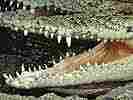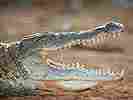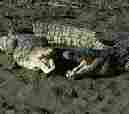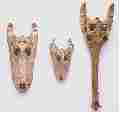
crocodiles
Wild Animals
alligators
baboons
bears
chimpanzees
crocodiles
deer
dolphins
elephants
foxes
giraffes
gorillas
leopards
lions
seals
sharks
snakes
tigers
whales
wolves
zebras
Pets
dogs
cats
fish
birds
|
This site provides you with the information about crocodiles, crocodile information online, crocodile pictures online, crocodile photos, crocodile pics for kids, images of crocodiles, crocodile description, free crocodile info, and more.
If you think that this site is helpful, please recommend your friends to visit our site.
crocodiles
I INTRODUCTION
Crocodile (reptile), common name for any of a number of reptiles in a family of the crocodilian order. The term crocodilian refers to all members of the order, which includes alligators, caimans, and gavials as well as crocodiles.
II CROCODILIANS
Crocodilians first appeared about 200 million years ago and are believed to be remnants of the great age of reptiles. Their ancestors originally lived on land and were lightly built, but they soon diversified into water-dwelling, or aquatic, and amphibious forms. Except for the alligators, crocodilians live in tropical and subtropical areas of the world. Modern crocodilians are amphibious, spending much of their time in water, where they swim with rhythmic strokes of the tail. The tail is sometimes used to capture prey, sweeping it from shallow to deeper water, where it can be devoured more easily.
Crocodilians are well-adapted as predators, with few natural enemies. Bony plates, called osteoderms, form a kind of armor in their thick skin. Their teeth, about 30 to 40 in each jaw, are set into sockets in the jawbones and interlock when the mouth is closed. In crocodiles, the fourth tooth on each side of the lower jaw protrudes when the mouth is closed; in alligators, these teeth are not visible. The jaws of crocodilians are powerful enough in closing to crush the bones of small animals, but so weak in opening that they can be held together by hand. As the crocodilian floats almost completely submerged, its protruding nostrils and eyes and a portion of its back are the only parts visible as it stalks its prey. Crocodilians are the most vocal reptiles, producing sounds from quiet hisses to fearsome roars and bellows, usually during the mating season. On land, crocodilians move quickly in a belly crawl but can also gallop and walk mammal-like on all four legs.
Crocodiles are physiologically the most advanced reptiles; their internal anatomy resembles that of birds. They have a four-chambered heart and well-developed senses. Cold-blooded like all reptiles-their body temperature depends on the environment-crocodilians bury themselves in mud to estivate or hibernate. In warm regions they are dormant during droughts; in colder regions, during winter.
Crocodilians are egg-laying, or oviparous, reptiles, reaching reproductive maturity at about the age of ten. The eggs, 20 to 90 in number and about the size of goose eggs, are buried in sand, mud, or vegetable debris, where they are left to hatch by the heat of the sun or of vegetable decomposition. Females of some species remain in the area to protect the nest and care for the newly hatched young, although many of the eggs and young are lost to predators. The parental behavior of crocodilians is unique among reptiles and points to their affinity with birds.
III THE CROCODILE
Some members of the crocodile family are the largest living reptiles. Crocodiles usually can be recognized by their long triangular snouts, intermediate between the long, narrow snouts of gavials and the short, oval snouts of alligators and caimans. The Indo-Pacific, or saltwater, crocodile, possibly the largest living reptile, is known to grow to a length of about 7 m (about 23 ft) and to weigh more than 1000 kg (more than 2000 lbs); there are unconfirmed reports of individuals up to 9 m (up to 30 ft) in length. This species inhabits the coastal waters of India, southern China, and Malaysia. A smaller species, the swamp crocodile, or mugger, is found in inland waters of India. The Nile crocodile of Africa was revered by certain ancient Egyptian sects, and mummies of crocodiles have been discovered in Egyptian tombs. In modern times this species has been hunted so extensively that few individuals remain in the lower Nile, but they are still abundant in the upper Nile and southward in Africa to the Cape of Good Hope. In the Americas there are four species of crocodiles. The Cuban crocodile, which has a relatively short snout and reaches about 3.5 m (about 11.5 ft) in length, is restricted to Cuba and the Isla de la Juventud. Morelet's crocodile, comparable in size to the Cuban crocodile, occurs along the Gulf Coastal Plain and Yucatán Peninsula of southern Mexico, Belize, and Northern Guatemala. The Orinoco crocodile inhabits drainages of the Orinoco River system and grows to about 6 m (about 20 ft). The American crocodile, the largest crocodile in the Americas, reaches lengths of about 7 m (about 23 ft) and inhabits a broad range from southern Florida southward, including Cuba and other Caribbean islands, southern Mexico, Central America, and northern South America.
Crocodile eggs are used for food in some parts of the world. The skin is highly valued for leather, and the extract from the musk glands is used in the manufacture of perfumes. Due to overhunting, most crocodiles-including the American and Nile crocodiles-are considered endangered species.
Scientific classification: Crocodiles belong to the genera Crocodylus,Osteolamus, and Tomistoma of the family Crocodylidae, order Crocodylia. The Indo-Pacific crocodile is classified as Crocodylus porosus, the swamp crocodile as Crocodylus palustris, the Nile crocodile as Crocodylus niloticus, the Cuban crocodile as Crocodylus rhombifer, the Morelet's crocodile as Crocodylus moreletii, the Orinoco crocodile as Crocodylus intermedius, and the American crocodile as Crocodylus acutus.




|